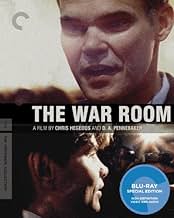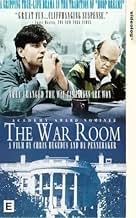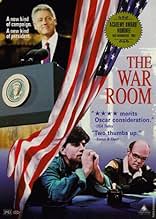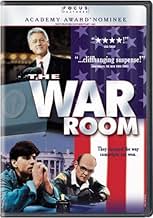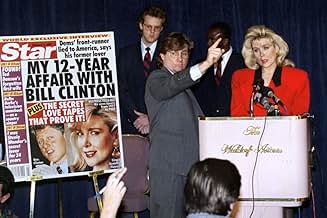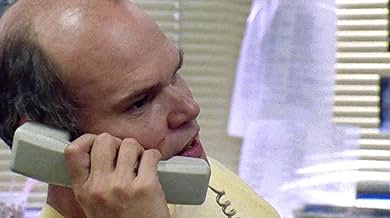Aggiungi una trama nella tua linguaFollows the Bill Clinton 1992 presidential campaign and the organization who ran it.Follows the Bill Clinton 1992 presidential campaign and the organization who ran it.Follows the Bill Clinton 1992 presidential campaign and the organization who ran it.
- Candidato a 1 Oscar
- 6 vittorie e 3 candidature totali
- Self
- (as Michael Donnilon)
- Self
- (as Stan Greenberg)
- Self
- (as Barry Bognato)
Recensioni in evidenza
Weak points: The sequence involving the Bush Brazilian print job goes on way too long and then doesn't resolve. Also, I (for one) was looking forward to seeing that timeless moment during the East Lansing debate when Clinton stepped away from the podium to address the draft issue, head on. That was a make-or-break moment that reminded us just how far a little candor can go when conventional political wisdom has us by the lapels, screaming in our faces. It's too bad the directors/editors didn't see fit to give us that critical moment, which I consider quite historical, not to mention on-topic.
All told, worth seeing. Interesting to watch something like this and remember that the pendulum sometimes swings...that way.
"The War Room" covers the Democratic side of the 1992 presidential campaign and election in which, you'll remember, Bill Clinton was pitted against George Herbert Walker Bush and Ross Perot. Kids -- Clinton won.
Some of the calculation that went on in the war room, the collective name for Clinton's campaign staff presided over by James Carville and George Stephanopoulis, surprised even me. I'll give one example, with rough quotes.
Carville is sitting around with his dozen or so co-conspirators and one of them brings up the idea of flooding the floor at the Democratic convention with signs in favor of gun control. "We've only got twelve hours," somebody says, "so where are we going to get signs?" "Can't we get the people to print the signs themselves?" Somebody says, "No, no. That way you're going to get a scattered couple of signs. Some will be red on white, other will be white on blue. It will send a mixed message. I just don't think it will have the same impact as a whole SEA of identical signs all over the floor." They're talking about this problem as if they're trying to solve it for the delegates and visitors on the floor of Madison Square Garden -- just being helpful, you know? -- whereas the WHOLE THING is their own idea! For all they know there may not be a single gun-control thought among the multitude of Clinton supporters, let alone enough to create a sea of signs! They carry on in the same way about most of the issues of the time and most of the current events. Bush's campaign is having its posters printed in Brazil. Can this fact somehow be turned against them? Not that the other side is virgin pure. Stephanopoulis has to deal with someone on the phone, evidently a journalist, inquiring about a rumor that Clinton has had a child by a black prostitute. Curiously similar to the rumor circulated about McCain when he opposed Bush during the 2004 primaries. In McCain's case, the rumor was accompanied by photos of "the black child," who was actually a Bengladesh girl that McCain and his wife had adopted. Nineteen ninety-two was only thirteen years ago but things have gotten a lot dirtier in that time.
As a movie, "The War Room" is informative, shot casually as the events transpired. There are no long speeches. But it's unfocused too and the editing sometimes leaves out important developments, which we learn about later. I suppose this can happen when you're just pointing the camera around and not providing a voice-over. And the film makers must have faced the additional problem that there is no logical narrative to the story. Stuff happens, abruptly and unexpectedly. It's not the careful reconstruction of an historic contretemps, like "The Thin Blue Line" or Ken Burns' "The Civil War." The candidates aside, the most memorable people in the film are James Carville, George Stephanopoulis, and Mary Matalin, Carville's opposite number on the Republican side. The two of them are from different political poles. Someone should be doing a cinema verite copy of their MARRIAGE. But they have a lot in common too. They're thick-skinned, devoted, have a sense of humor, and are animated. Carville's face is so curiously constructed that it looks devilishly lively even in repose. He comes from an old New Orleans family. The hospital for lepers at Carville is named for his ancestors who founded it.
I can't say I like George Stephanopoulis too much. He looks like the president of my senior class in high school. He's self-contained, intelligent, thoughtful, clean-cut, handsome, and is much younger than I am. I could live with all the other stuff, but his youth is inexcusable. I'd have liked him a lot better as a stuttering, kyphotic octogenarian who was able to touch the tip of his nose with the tip of his tongue. And his hair was styled so boyishly that I didn't like THAT either.
The personality that's most memorable is Carville's though. He sits there smiling on election eve and begins imagining what Clinton would say at his concession speech should Bush win. And between the chuckles he spins out an improvised, absolutely spot-on by-the-numbers speech for the Governor. I would like to congratulate President Bush on his victory tonight and assure him that all of us are behind him and that this will be a better America with our help and God's and my family most of all my wife Hillary and Chelsea and all those of you who have worked so hard on this campaign I'd like to mention So-and-So and our prayers are with the President and let us all cooperate now and move together towards a greater American co-prosperity sphere, no not that, but a more prosperous and happier American which with God's blessing and blah blah blah. I couldn't stop laughing.
The documentary follows the 1992 Clinton Campaign from the doldrums in New Hampshire, through the Democratic convention in New York to its summit on election night in Little Rock. But Clinton spends very little time on the screen. The film captures the behind-the-scenes action of James Carville, George Stephanopolis, and the rest of the cast and crew of Clinton campaign headquarters. The film shows how TV spots are written, how interviews are managed, how the candidates' message is distributed, and how the "spin doctors" do their stuff.
The pace is quick. Staffers come into and out of scenes constantly, and there is a great deal of off-camera dialogue, much like an emergency-room scene from E.R. The mix of standard documentary footage with news reports and interviews is terrific. Some of the best scenes are of the pols watching the news reports and reacting to what they see.
The central character is James Carville, who is more interesting than anyone else in the campaign, much moreso than the candidates themselves. He reveals that his "Ragin' Cajun" image is genuine, for he is truly passionate about his work. But it also reveals a mind working on overdrive, and a sensitive nature that you wouldn't expect to see. His "people will say you are lucky" speech to staffers at the end of the film is as moving as anything written for the studio, and moreso because it is genuine.
Stephanopolis came off less well. Behind his youthful looks and seeming intelligence comes a certain shallowness. Much of his contribution was more of a "me too" nature than anything truly creative or deep. He also had a moment at the end of the film when, in a room with a starry-eyed female staffer, he's describing how he feels. And the conclusion is, not much. It is not hard to understand why years later George was a washout in the Clinton White House, never managed another campaign, and is now earning his living in front of the camera.
After all is said and done, it is clear that the candidate is secondary in a modern presidential election. He's like the hand your dealt in a game of poker. It's important, but what you do with it once it is dealt to you is much more important. And these guys are pros.
So are the filmmakers. There were several times when I had to remind myself that this was a documentary, and not a work of fiction. In fact, if you see it immediately after seeing "Primary Colors" you'll see that truth is not only stranger than fiction, but it can be more interesting as well.
Lo sapevi?
- QuizParodied in The Bunker (2016) of Documentary Now! (2015)
- Citazioni
James Carville: There's a simple doctrine: outside of a person's love, the most sacred thing that they can give is their labor. And somehow or another along the way, we tend to forget that. Labor is a very precious thing that you have. Anytime that you can combine labor with love, you've made a good merger. I think that we're gonna win tomorrow, and I think the governor's going to fulfill his promise and change America. And I think many of you are going to go on and help him. I'm a political professional, that's what I do for a living, and I'm proud of it.
[weeping]
James Carville: We change the way campaigns are run. It used to be, there was a hierarchy. If you were on one floor, get to another floor. Everybody was compartmentalized. You people showed that you can be trusted. Everybody in this room, everybody. People are gonna tell you you're lucky. You're not. Ben Hogan said 'Golf is a game of luck. The more practice, the luckier I get.' The harder you work, the luckier you are. I was thirty-three years old before I went to Washington or New York. Forty-two before I won my first campaign. And I'm happy for all y'all. You've been part of something special in my life... and I'll never forget what y'all have done. Thank you.
- Colonne sonoreVote for the Rythm
Written by Leo Robin, Ralph Rainger, Al Siegel
Performed by Ella Fitzgerald/Chick Webb Band
Published by Famous Music Corp.
I più visti
- How long is The War Room?Powered by Alexa
Dettagli
Botteghino
- Lordo Stati Uniti e Canada
- 901.668 USD
- Fine settimana di apertura Stati Uniti e Canada
- 15.264 USD
- 7 nov 1993
- Lordo in tutto il mondo
- 901.668 USD
Contribuisci a questa pagina




